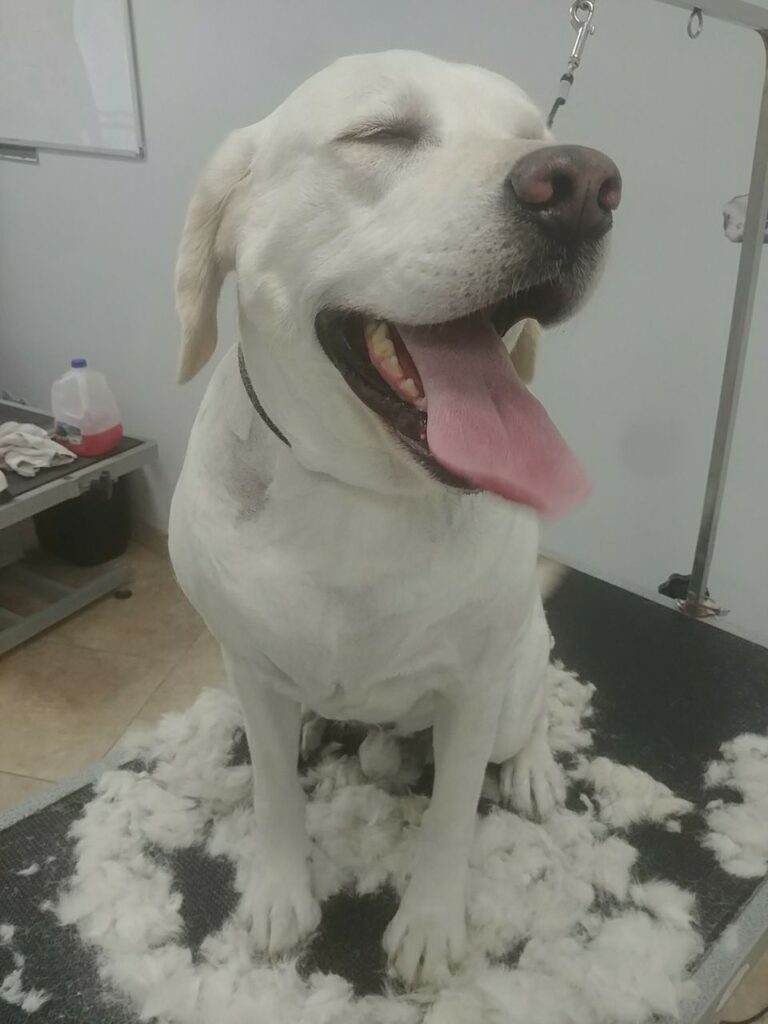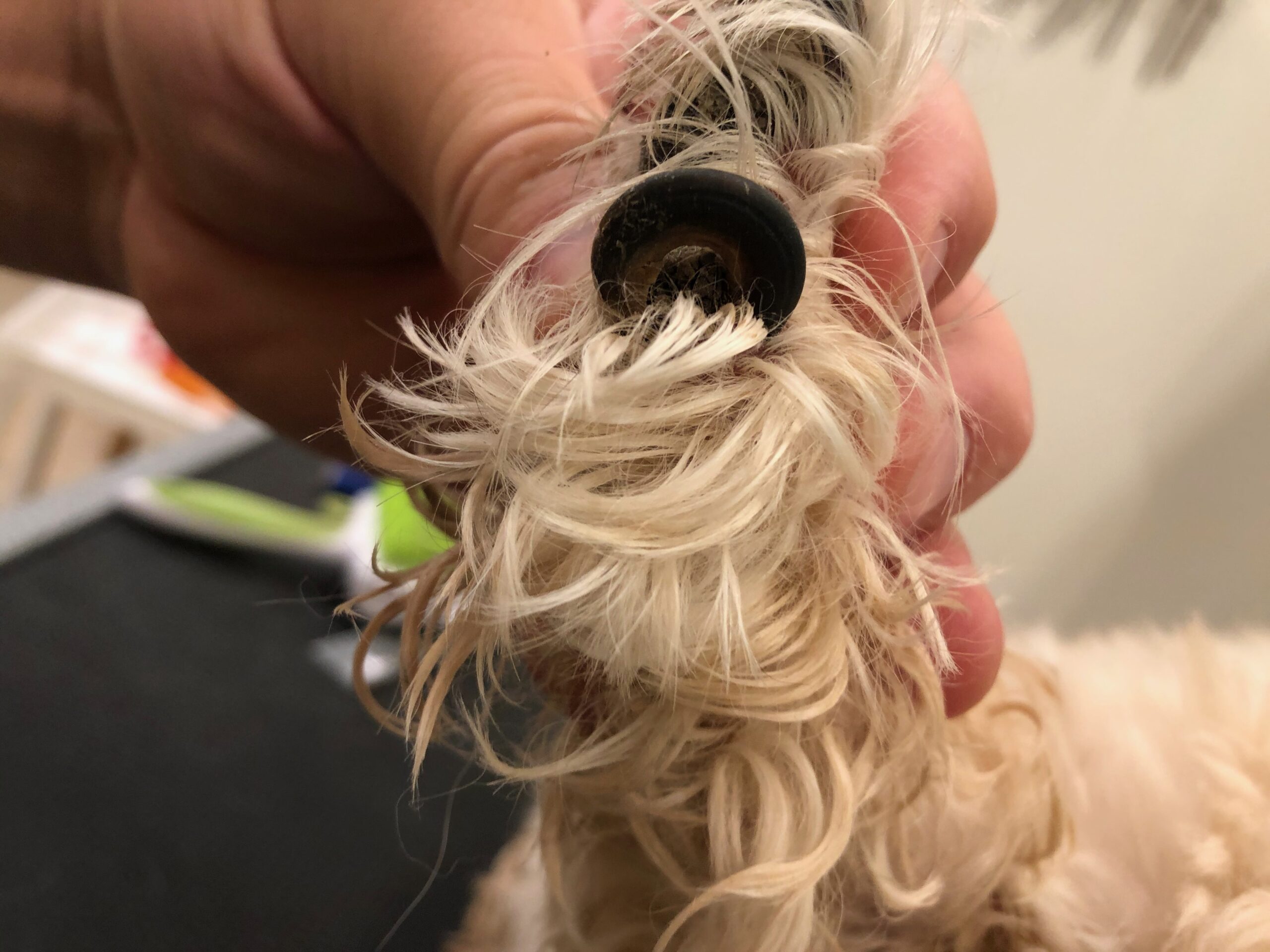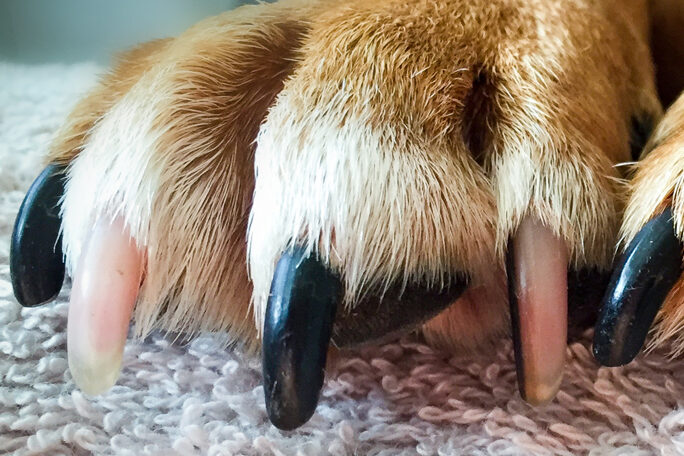Dog Nail Trimming
General Nail Information
Dog's nails are one of the most difficult forms of dog grooming. Our customers talk about their dog's nails more than any other part of dog grooming. Sure a clean dog is needed continuously but bathing is usually not as difficult as dog nail trimming.
Dog's nails are all over the place in terms of complexity. There are many variables to trimming dog's nails. We'll name a few and later discuss some ways to overcome them.
- Temperament - Dogs don't like their nails trimmed; none of them. You might have a dog that performs the handshake but as soon as the clipping starts there's doubt and some form of resistance/hesitation. This is common and normal. In order for nails to keep their ideal length the quick has to be distressed. Quick is sensitive to the dog. When they were wolves out in the wild the quick adjusted itself naturally as the dog used their nails. As dogs have evolved through domestication their nails require assistance.
- Size - Dog nail sizes vary. Some are small and some are large. Some dog nails are very small and grow real close to their pads. When nails grow real close to their pads it can be impossible to fit standard dog nail clippers to clip nails without pinching their pad.
- Condition - The condition of the dog nails can play a large role in how they're to be trimmed and frequency. The condition has many forms but here are a few:
- Brittle - Nails break or split easily.
- Black - There's no visibility of the quick externally.
- Length - The nails are so long they are curling into the pads.
There are many YouTube videos out there and plenty of information on technique. Here we're going to try and share our experience and some of our techniques for overcoming some of this variables.
Temperment
Temperament is probably the more difficult challenge when performing dog nail  trimming. You're trying to perform a precision trim while and animal is trying to bite or run away from you! This is the main reason why so many dog owners shy away from performing dog nail trimming on their own. They want to perform maintenance on their dog but don't want to hurt them either, which is one reason why professional dog grooming exists.
trimming. You're trying to perform a precision trim while and animal is trying to bite or run away from you! This is the main reason why so many dog owners shy away from performing dog nail trimming on their own. They want to perform maintenance on their dog but don't want to hurt them either, which is one reason why professional dog grooming exists.
When first approaching the dog with nail trimming see how they react to the tools. We like to let them smell and see the tools. Whether you like it or not the dog has to choose to allow you to clip their nails. This is a mutual agreement between you and the dog to perform nail trimming. If the dog trusts you and the tools it will be more likely to allow you to perform the nail trimming. Dogs want trust and you should too. Gain their trust by introducing what you're doing.
Some dogs are uncomfortable and you don't know it. Dogs that have bad hips, over-weight, or some other physical complications might be experiencing discomfort when you put them on three legs or less than what they're used to. Keeping them supported can help minimize potential discomfort. This can be recognized if a dog is ok with you holding their feet for a few seconds and then later starts whining or pulling and you've not really started to trim. This is not always the case but something to consider.
Go slow. Quick movements toward their feet does not build trust. It doesn't need to be super slow but gentle. Take your time when performing dog nail trimming. Once the paw is in position you can trim as quickly as you're skilled but the initial grabbing of their paw and moving into position can be gentle and slow. When we say slow we don't mean timid. Timid or uncertainty can break trust and lead to defensiveness. Be forward with your movements, like you do this all day everyday, like us.
You will need to become proficient at different positions. The dog will move likely  many times looking for either more comfortable positions or looking to move away. Staying flexible and learning to be proficient at different positions means you can adjust with the dog without requiring them to be in a single position. Allowing them to move a little can minimize some anxiety, but remember you still want to be forward here. Position setting can be a great way to gain some respect momentarily while you work.
many times looking for either more comfortable positions or looking to move away. Staying flexible and learning to be proficient at different positions means you can adjust with the dog without requiring them to be in a single position. Allowing them to move a little can minimize some anxiety, but remember you still want to be forward here. Position setting can be a great way to gain some respect momentarily while you work.
Moreover, as they move around you might work different nails. You don't have to work one paw before you can move to the next. Do what you can when you have it. Just be sure to check them all before you're done to ensure you got them all.
Distractions, maintaining the dog's focus is a great technique. There are unlimited ways to distract a dog, but for the most part there's visual distractions, attention, toys, and food. Holding a dog can be a form of attention and can provide security for some. People or dogs walking by can catch their eye. Sometimes this can be the opposite of helpful. Food or chews can be great, especially for puppies. Many puppies have no discipline and just want to play all the time. A good chew can distract them while you work. You might need bacon or some very tasty treat for this to work. Some treats that are not super tasty will be effective enough during nail trimming. And, finally toys are another distraction that can work.
When working with a biter it's best to keep all parties involved safe. No one wants to be hurt. Listen to your dog's body language. Showing of teeth, growling, blank stares, or quickly looking at what you're doing are all signs a potential bite is about to happen. Try to keep your hands out of their face. A quick nip and do a lot of damage. If they at least need to turn their head before biting you might have half a second to pull away. Find a way to maintain control. Some ways to maintain control might be to grab ahold of their scruff. No need to really pull but should there be an attempt to bite you can keep just enough distance if needed. Placing the forearm or portion of your elbow on their neck can also help maintain some distance. These techniques are no way one size fits all but depending on the body and situation some may be helpful. No matter the situation if you don't feel safe, don't do it. Visit us or find a professional. There are some dog trainers out there who also may be able to help.
Always pay attention to your dog's body language when performing grooming. A quick look back at what you're doing usually means something hurt. Continual bitting is aggravated. Not wanting to stand can be soreness or achy. Some shaking is normal. Learn dog's body language so you can best understand your dog's temperament.
Size
Various sizes can be a layer of complexity when trimming dog nails. There are many different tools available to help address different sizes. We like to use either a Dremel or standard clippers. You want to find a set of clippers fit the nails you plan to trim. Too small or thin can buckle or twist when trying to trim nails. Thicker or larger nail trimmers are needed if this occurs. You may need to try a few before you find the ones that work best for you.
Condition

Dog nail condition can be another main area for complication. With the previous challenges already mentioned you now also might have to deal with the condition of the nails.
Dog nails want to be trimmed about every 30 days. This is not true for every dog or even every nail. Some dogs will be different. This is an average and you should adjust as needed. We usually inform people that if you can hear the nails hitting the floor it's usually time to trim.
We trim every 2 weeks to return nails back to their desired length and once they're shorter we can back off to a maintenance recurrence of 30 days.
When dealing with a full nail curl one technique is to use a Dremel. A Dremel can take down nails in smaller amounts which can be important to not split or crack a nail. Dremels are some times not as desired as they make noise and provide a vibration sensation for the dog. If the dog allows a Dremel they're great for trimming at weird angles or working on really long nails.
A Dremel is also beneficial for working with nails that are soft, cracking, or prone to cracking. Dremels are great for removing small amounts of nail at a time.
Dremel®
Dremels cause vibration on the nail and can irritate some dogs more than others. Using different grit sandpaper can help change the frequency of vibration. Alternative angles can also help. You want a smooth operation.
Don't press too hard or sit in one place for too long. Dremels move fast and can get hot.
Always be mindful of pads when using the Dremel. The edge or backside of a Dremel can touch pads which leads to burning. If you want to know how much time you have to touch a pad touch yourself with the Dremel. You have about a half a second before it starts to hurt. This may sound unusual but knowing how things feel is a great way to understand perspective, on somethings. We're not dogs so let's not get crazy.
Conclusion
Nail maintenance is just a normal maintenance that needs to be performed often on the majority of dogs. It's not exciting for either party but hopefully with some if our insight your next nail trim will be easier. We want dogs to comfortable and well maintained. People are busier than ever these days and taking the time to perform dog nail trim maintenance can be too time consuming. It's also ok to have someone else perform this service. We perform dog nail trimming for many our customers here in Phoenix, AZ. Dog nail trimming is a skill and with enough time you too can become proficient.

